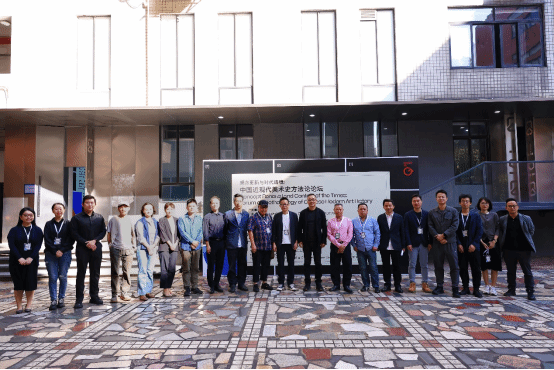
10月31日,“中国近现代美术史方法论论坛”在广州美术学院昌岗校区举办。该论坛由广州美术学院主办,广州美术学院中国近现代美术研究所、广州美术学院艺术与人文学院承办,邀请了14位国内外在美术史研究领域享有盛誉的学者,以“路径与视域”“个案与方法”“媒介与观念”为议题,共同探讨了中国近现代美术史领域新近的研究方法论,同时也期望促进中国近现代美术史研究的范式更新。
On October 31, the "Forum on Methodology of Chinese Modern Art History" was held at the Changgang Campus of Guangzhou Academy of Fine Arts (GAFA). The forum was hosted by Guangzhou Academy of Fine Arts, and undertaken by the Research Center for Chinese Modern Art (RCCMA) and the School of Arts and Humanities of Guangzhou Academy of Fine Arts. Fourteen scholars with high reputation in the field of art history research at home and abroad were invited to discuss the latest research methodology in the field of modern Chinese art history with the topics of "path and field of vision", "individual cases and methods" and "media and concept", and also hoped to promote the paradigm update of modern Chinese art history research.
广州美术学院院长范勃,中国美术馆原副馆长、广州美术学院中国近现代美术研究所原所长梁江,中国艺术研究院研究员、美术研究所副所长(主持工作)杭春晓,广州美术学院艺术与人文学院院长胡斌,广州美术学院艺术与人文学院副院长郭伟其,广州美术学院艺术与人文学院教授蔡涛,美国普吉湾大学终身教授洪再新教授,国际日本文化研究中心综合研究大学院大学教授战晓梅,美国路易维尔大学美术系美术史与建筑史摩根讲席教授赖德霖,江苏省美术馆副馆长万新华,广州美术学院美术学报编辑部主任常务副主编李若晴,韩国德成女子大学人文科学研究教授赵敏住,深圳市关山月美术馆副研究员丁澜翔,中山大学艺术学院教授杨小彦,中央美术学院人文学院教授吴雪杉,广州美术学院中国近现代美术研究所助理研究员许珍;以及圆桌会议嘉宾:广州美术学院中国画学院教授李伟铭,中山大学历史学系副教授艾姝,中山大学新闻传播学院副教授郑梓煜,广州美术学院跨媒体艺术学院教授杨简茹,广州美术学院美术馆展览部主任何小特,广州美术学院中国画学院副研究员王艾,广州美术学院图像与历史高等研究院助理研究员陈旭,广州美术学院中国近现代美术研究所助理研究员王琳等出席了论坛。
The Forum was attended by Fan Bo, President of Guangzhou Academy of Fine Arts; Liang Jiang, former Deputy Director of the National Art Museum of China and former Director of RCCMA of GAFA; Hang Chunxiao, Researcher of the Chinese National Academy of Arts and Deputy Director of the Art Institute of the Chinese National Academy of Arts (Host); Hu Bin, Dean of the School of Arts and Humanities of Guangzhou Academy of Fine Arts; Guo Weiqi, Deputy Dean of the School of Arts and Humanities of Guangzhou Academy of Fine Arts; Cai Tao, Professor of the School of Arts and Humanities of Guangzhou Academy of Fine Arts; Hong Zaixin, Tenured Professor at the University of Puget Sound; Zhan Xiaomei, Professor at the International Research Center for Japanese Studies and the Graduate University for Advanced Studies; Lai Delin, Associate Professor in Art Department of University of Louisville; Wan Xinhua, Deputy Director of Jiangsu Art Museum; Li Ruoqing, Editorial Director (Executive Deputy Director) of Art Journal of Guangzhou Academy of Fine Arts; Cho Min Ju, Research Professor of the Institute for Humanities Research of Duksung Women’s University in South Korea; Ding Lanxiang, Associate Researcher of Guan Shanyue Art Museum, Shenzhen; Yang Xiaoyan, Professor at the School of Art of Sun Yat-sen University, Wu Xueshan, Professor at the School of Humanities of the Central Academy of Fine Arts , and Xu Zhen, Assistant Researcher at the RCCMA of GAFA; as well as roundtable guests: Li Weiming, Professor at the School of Chinese Painting of Guangzhou Academy of Fine Arts , Ai Shu, Associate Professor at the Department of History of Sun Yat-sen University, Zheng Ziyu, Associate Professor at the School of Journalism and Communication of Sun Yat-sen University, Yang Jianru, Professor at the School of Tansmedia Art of Guangzhou Academy of Fine Arts, He Xiaote, Director of the Exhibition Department of the Art Museum of Guangzhou Academy of Fine Arts, Wang Ai, Associate Researcher at the School of Chinese Painting of Guangzhou Academy of Fine Arts, Chen Xu, Assistant Researcher at the Institute for Advanced Studies of Images and History of Guangzhou Academy of Fine Arts, and Wang Lin, assistant researcher at the RCCMA of GAFA.
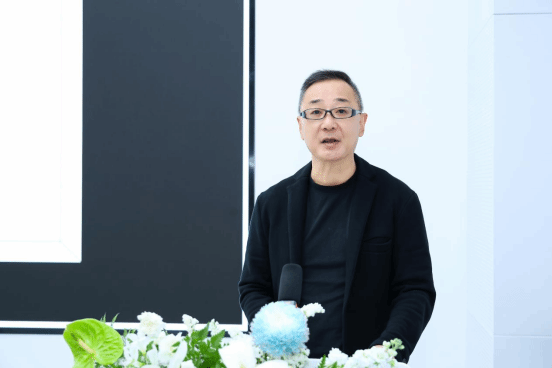
论坛开幕式上,范勃院长代表学校对国内外来校参加论坛的嘉宾表示热烈欢迎。他强调广东作为中国近现代社会改革与思想解放的先行地,深刻影响了广州美术学院与中国近现代美术研究所的学术研究方向。他介绍了在参与和推动中国近现代美术的现代化转型进程中,广州美术学院与中国近现代美术研究所做出的努力,特别是从观念思维和具体实践层面,为变化中的学术研究提供方法论的导引,助力了中国气派的学术体系及话语体系的建设。在近年来新史料的不断涌现和研究工具、方法迭代更新的基础上,他期望能以此论坛为契机,促进知识的交流与启发,成为友谊与合作的新起点。最后他倡议以共同的创新价值导向出发,寻找构建一个积极有效、相互促进的学术共同体机制,并进一步推动中国近现代美术研究与方法论的革新。
At the opening ceremony, President Fan Bo, on behalf of the Academy, extended a warm welcome to the guests from home and abroad who came to attend the forum. He emphasized that Guangdong, as a pioneer of China's modern social reform and ideological emancipation, has profoundly influenced the academic research direction of GAFA and RCCMA. He introduced the efforts made by GAFA and RCCMA in participating in and promoting the modernization transformation of modern Chinese art, especially from the perspective of conceptual thinking and specific practice, providing methodological guidance for changing academic research, and contributing to the construction of a Chinese style academic system and discourse system. Based on the continuous emergence of new historical materials and the iterative update of research tools and methods in recent years, he hopes to take this forum as an opportunity to promote the exchange and inspiration of knowledge and become a new starting point for friendship and cooperation. Finally, he proposed to start from the common innovation value orientation, find a mechanism for building a positive, effective and mutually reinforcing academic community, and further promote the innovation of research and methodology of modern Chinese art.
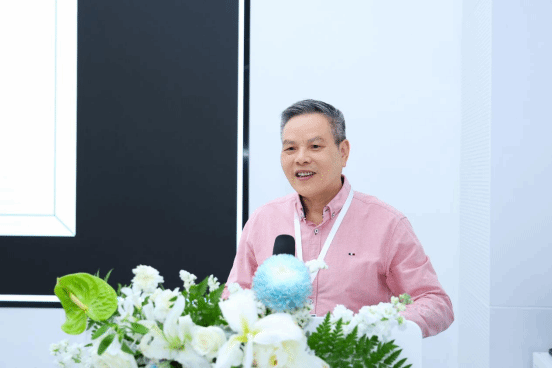
致辞嘉宾梁江先生从三个方面对此论坛的召开发表感言,首先,他以自身经历的学术背景出发,介绍了广州美术学院和中国艺术研究院美术研究所的历史沿革以及在中国近现代美术革命进程中所担任的角色,同时他肯定了各位学者对过往学术研究的继承与发展。其次,他认为此次论坛在广州召开具有强烈的象征意义,这些方法论的源头可以追溯到广州发生的一些事件。从敦煌学的提出,到史学研究分为史料派和史观派,这种个案与宏观的方法论的分门别类正对应了今天召开论坛的个案与观念研究。同样,这也让他回忆到20世纪80年代思想改革时,学界对于方法论的专门研究与激烈讨论。他引用李泽厚曾经的观点:“一个是看树木,一个是看森林。”这也就是史学两个基本不同的方法论。最后,他介绍了一些关于大数据与史料和史学研究的文献,并且强调了在AI时代的背景下,大数据模型等新方法对于前沿学术研究的重要性。他希冀通过此论坛的学术交流,各位学者的未来的学术研究能有更加新颖的成果。
The guest speaker, Mr. Liang Jiang, expressed his feelings about the convening of this forum from three aspects. First, based on his own academic background, he introduced the historical evolution of Guangzhou Academy of Fine Arts and the Art Institute of the Chinese Academy of Arts and the role they played in the process of China's modern and contemporary art revolution. At the same time, he affirmed the inheritance and development of past academic research by scholars. Secondly, he believed that the convening of this forum in Guangzhou had symbolic significance, and the source of these methodologies could be traced back to some events that took place in Guangzhou. From the proposal of Dunhuang studies to the division of historical research into historical material schools and historical view schools , this classification of case and macro methodology corresponds to the case and concept research of today's forum. Similarly, this also reminded him of the special research and intense discussion of methodology in the academic community during the ideological reform in the 1980s. He quoted Li Zehou's previous view: "One is to look at the trees, and the other is to look at the forest." These are two basically different methodologies in historiography. Finally, he introduced some literature on big data and historical materials and historical research, and emphasized the importance of new methods such as big data models for cutting-edge academic research in the context of the AI era. He hopes that through the academic exchanges at this forum, scholars' future academic research will produce more innovative results.
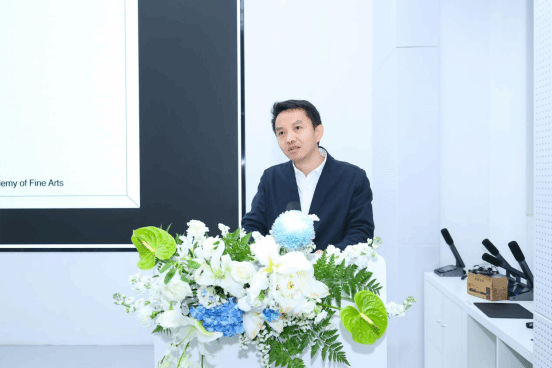
参加开幕式的还有广州美术学院党政办主任林丰、广州美术学院党政办副主任彭新东,以及各二级学院的教师和同学们。开幕式由广州美术学院艺术与人文学院院长胡斌教授主持。
The opening ceremony was also attended by Lin Feng and Peng Xindong, Director and Deputy Director of the University Office of Guangzhou Academy of Fine Arts, as well as teachers and students from various Schools. The opening ceremony was hosted by Professor Hu Bin, Dean of the School of Arts and Humanities of Guangzhou Academy of Fine Arts.
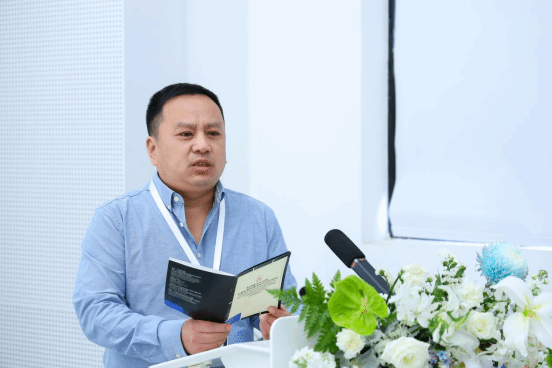
开幕式后进行第一单元的议题“路径与视域”,该单元由江苏省美术馆研究馆员、副馆长万新华主持。
After the opening ceremony, the first unit topic “Path and Field of Vision” was held, which was hosted by Wan Xinhua, research curator and deputy director of Jiangsu Art Museum.
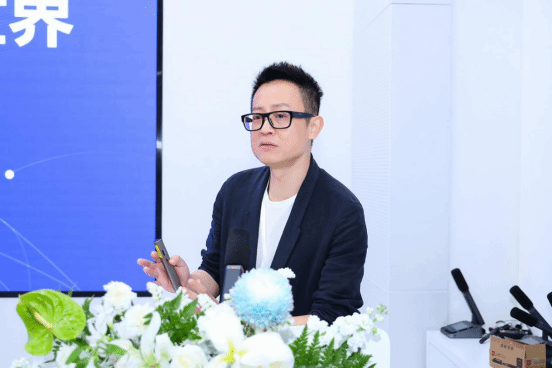
中国艺术研究院研究员、美术研究所副所长杭春晓以《跨文化中的“潮汐效应”——1920年代中国语境中的“世界性”与“现代艺术”》为题,分别以“误读性”认知、现代等同于中国传统、从“误读”到“认知”的回传——“潮汐效应”、“潮汐效应”下的中国回响、世界性——传统即现代的“西化”等四个维度阐释了他提出的“潮汐效应”概念。最后,他强调“潮汐效应”是去中心化的世界性,“潮汐效应”打破了国家之间的区隔,寻求世界性的人类艺术,使1920年代的中国在看似小众的美术界,获得思考方法上的意外收获。
Hang Chunxiao, Researcher at the Chinese Academy of Arts and Deputy Director of the Art Institute, gave a speech entitled "The Tidal Effect in Cross-Culturalism - Worldliness and Modern Art in the Context of China in the 1920s". He explained the concept of "tidal effect" he proposed from four dimensions: "misreading" cognition, modernity being equal to Chinese tradition, the feedback from "misreading" to "cognition" - "tidal effect", "Chinese echo under the tidal effect", and worldliness - "Westernization", tradition equals modernity. Finally, he emphasized that the "tidal effect" is decentralized worldliness. The "tidal effect" breaks the divisions between countries and seeks worldly human art, which makes China in the 1920s gain unexpected gains in thinking methods in the seemingly niche art world.
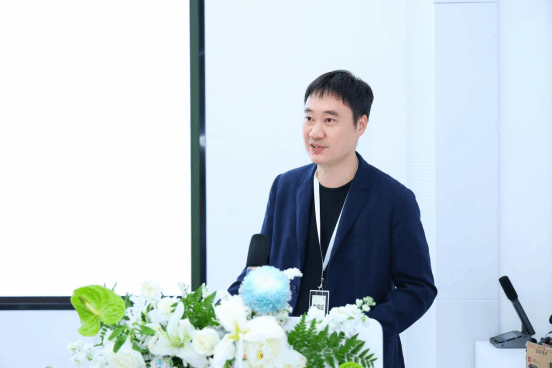
广州美术学院艺术与人文学院副院长郭伟其以《创造意义:图像学的困境与机遇》为题关涉到中国近现代美术史研究,从意义的确认与搁置、艺术史VS当代文化、(中国)近现代美术史的位置、研究机制与责任等四个方面去阐释图像学研究,以及如何运用图像学方法论。他列举了图像学研究学者潘诺夫斯基的经典理论、瓦尔堡研究院的图像学研究、米切尔的图像学研究等案例去探讨当下图像学研究面临的问题。最后,他提到了元图像概念,这是对于图像学今天来说意味着的某种提示。他强调道,图像的意义是在综合环境中被创造出来,我们可以去体验这样一种创造力,同时,也可以通过这样的研究诸如此类的图像,把这些问题进行历史化书写。
Guo Weiqi, Vice Dean of the School of Arts and Humanities of Guangzhou Academy of Fine Arts, spoke on the topic of "Making Meaning: Dilemmas and Opportunities in Iconography", which concerns the study of modern and contemporary Chinese art history. He explained iconographic research from four aspects: confirmation and shelving of meaning, art history VS contemporary culture, the position of (Chinese) modern and contemporary art history, research mechanism and responsibility, and how to use iconographic methodology. He cited cases such as the classic theory of iconographic researcher Panofsky, the iconographic research of the Warburg Institute, and the iconographic research of Mitchell to explore the problems facing current iconographic research. Finally, he mentioned the concept of meta-image, which is a hint of what iconography means today. He emphasized that the meaning of images is created in a comprehensive environment. We can experience such creativity, and at the same time, we can write these issues in a historical way through such research on images.
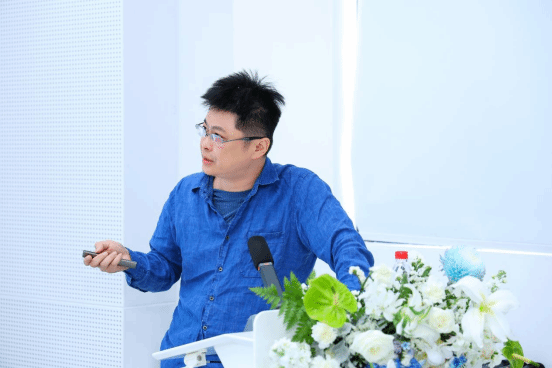
广州美术学院艺术与人文学院教授蔡涛发言的题目为《陷阱或是通路——通过原作理解现代美术史》,萦绕他的问题是“关于画中画的悬疑”,他提到,在西方的世界中,艺术品修复和运用X光分析艺术作品已经可以佐证和配合美术史研究。这种研究方法也指向了一个尖锐的问题——艺术作品的真伪,一种情况艺术家会自己改动曾经的作品,也有一种情况是一些家属在艺术家逝世后做伪作以此来冒充真迹。最后,他强调在美术史研究中,面对不辨真伪、源流、弄不清时代甚至不能看懂的作品,要进行理论分析时,就要尝试重建这个对象曾经的面貌。
Cai Tao, Professor of the School of Arts and Humanities at the Guangzhou Academy of Fine Arts , spoke on the topic of "Trap or Access - Understanding the History of Modern Art through the Original Work". The question that lingered in his mind was "the mystery of paintings within paintings". He mentioned that in the Western world, art restoration and the use of X-rays to analyze works of art can already support and cooperate with art history research. This research method also points to a sharp issue - the authenticity of works of art. In one case, artists change their past works themselves, and in another case, some family members forge works after the artist's death to pass them off as authentic works. Finally, he emphasized that in the study of art history , when faced with works that cannot be distinguished from authenticity, origin, unclear era, or even incomprehensible, when conducting theoretical analysis, we must try to reconstruct the former appearance of this object.
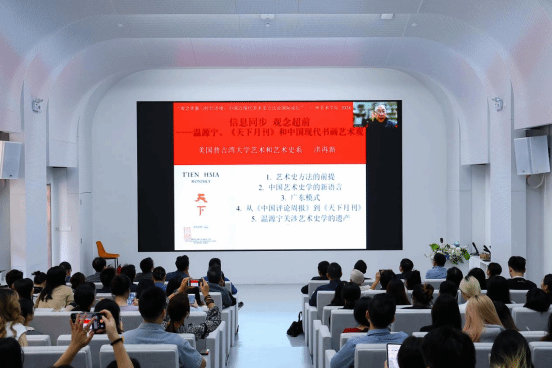
美国普吉湾大学终身教授洪再新以《信息同步 观念超前——温源宁、<天下月刊>和中国现代书画艺术观》为题进行发言,他谈及艺术史方法的前提、中国艺术史学的新语言、广东模式、从《中国评论周报》到《天下月刊》、温源宁关涉艺术史学的遗产等四个维度,他考察艺术史语言的立场,特别是放在广东模式下来了解陆丰人温源宁在主编英文《天下月刊》的六年中所做的贡献。最后,他希望因此研究,能够对温源宁关涉艺术史学留下来的遗产做系统和深入的开掘与整理。
Hong Zaixin, a Tenured Professor at the University of Puget Sound, gave a speech entitled "Information Synchronization and Advanced Thinking - Wen Yuanning, T’ien Hsia Monthly and the Artistic View of Chinese Modern Painting and Calligraphy". He talked about the premise of art history methods, the new language of Chinese art history, the Guangdong model, from The China Critic to T’ien Hsia Monthly, and Wen Yuanning's legacy in art history. He examined the position of art history language, especially in the Guangdong model to understand the contribution made by Wen Yuanning, a native of Lufeng , in the six years he edited the English T’ien Hsia Monthly. Finally, he hoped that this study would enable a systematic and in-depth excavation and arrangement of Wen Yuanning's legacy in art history.
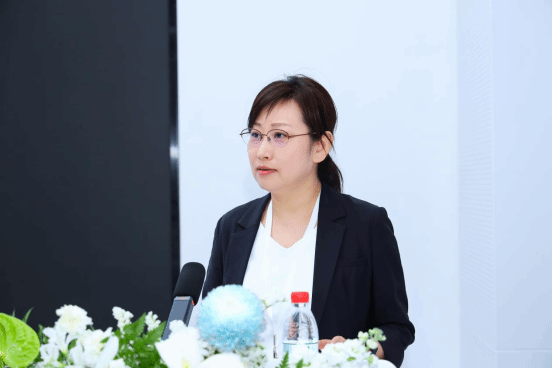
国际日本文化研究中心综合研究大学院大学教授战晓梅发言的题目为《从文化史角度出发的美术史研究》,她从“中日绘画联合展览会”的研究出发,探析展览背后的文脉背景,提出一个从文化史角度解读美术交流现象的思路。她提出问题——是何因素促成了中日主办方的一拍即合?为何核心人物是美术史上不知名的渡边晨亩?展览成功的背后潜藏着中日双方传统画坛怎样的处境和诉求?通过一系列的介绍与分析,最后她认为,以上这些问题都能够归结到中日传统画坛自我保护的共同需求,以及借助外力摆脱困境方策上的一致。
Zhan Xiaomei, Professor of the International Research Center for Japanese Studies and the Graduate University for Advanced Studies spoke on the topic "Art History Research from the Perspective of Cultural History". She started from the research of the "Sino-Japanese Painting Joint Exhibition", explored the contextual background behind the exhibition, and proposed an idea to interpret the phenomenon of art exchange from the perspective of cultural history. She raised the question - what factors led to the instant cooperation between the Chinese and Japanese organizers? Why is the core figure Watanabe Shinpo, who is unknown in the history of art ? What kind of situation and demands are hidden behind the success of the exhibition in the traditional painting communities of China and Japan? Through a series of introductions and analyses, she finally believed that the above problems can be attributed to the common need for self-protection of the traditional painting communities of China and Japan, and the consensus on the strategy of using external forces to get out of the predicament.
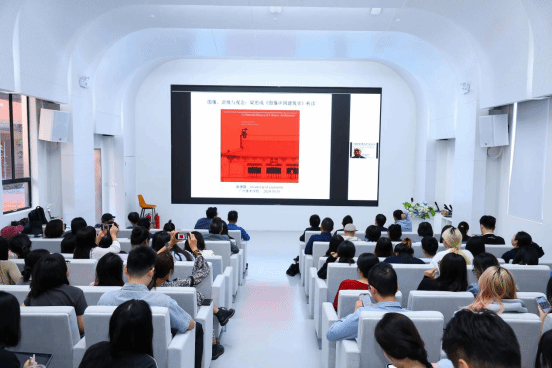
美国路易维尔大学美术系美术史与建筑史摩根讲席教授赖德霖以《图像、语境与观念:梁思成<图像中国建筑史>析读》为题进行发言,他认为梁思成书中的“中国建筑”并非是一种不加取舍、忠实客观的“呈现”,而是经过他的主观选择和加工后的“再现”。他强调梁思成的观念体现了当时学术语境中有关中国建筑“彩饰”和“非历史性”欧洲中心主义偏见的回应。最后,他希望能通过对梁思成《图像中国建筑史》的分析与介绍,再现与还原中国建筑原有的辉煌,以及中国学者为抢救和复兴这一伟大艺术传统所付出的积极努力。
Lai Delin, Associate Professor in Art Department of University of Louisville, gave a speech entitled "Image, Context and Concept: an Analysis of Liang Sicheng's "A Pictorial History of Chinese Architecture". He believed that the "Chinese architecture" in Liang Sicheng's book was not a "presentation" without selection, faithfulness and objectivity, but a "reproduction" after his subjective selection and processing. He emphasized that Liang Sicheng's concept reflected the response to the "color decoration" and "non-historical" Eurocentric prejudice of Chinese architecture in the academic context at that time. Finally, he hoped to reproduce and restore the original glory of Chinese architecture and the positive efforts made by Chinese scholars to rescue and revive this great artistic tradition through the analysis and introduction of Liang Sicheng's "A Pictorial History of Chinese Architecture".
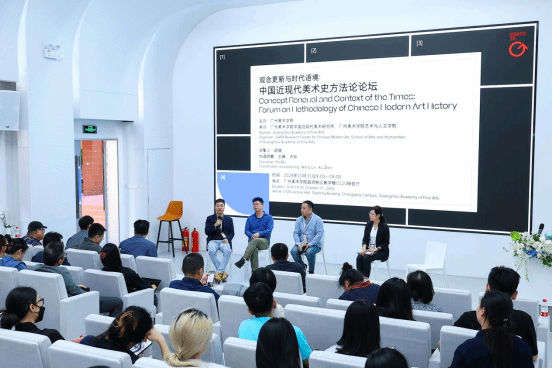
第一单元结束后,郭伟其、蔡涛、万新华、战晓梅、丁澜翔等嘉宾聚焦于“路径与视域”的议题进行了圆桌讨论。
After the first unit ended, guests including Guo Weiqi, Cai Tao, Wan Xinhua, Zhan Xiaomei, and Ding Lanxiang held a roundtable discussion focusing on the topic of "Path and Field of Vision".
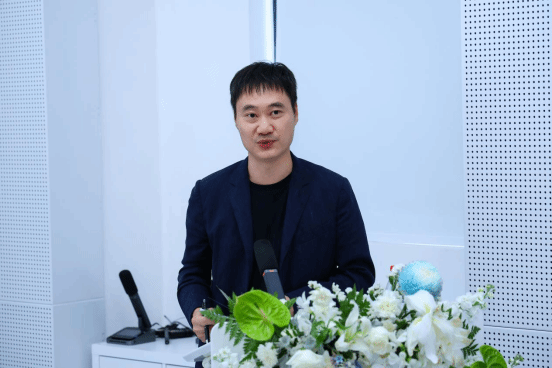
第二单元的议题为“个案与方法”,该单元由郭伟其主持。
The topic of the second unit was "Individual Cases and Methods", which was hosted by Guo Weiqi.
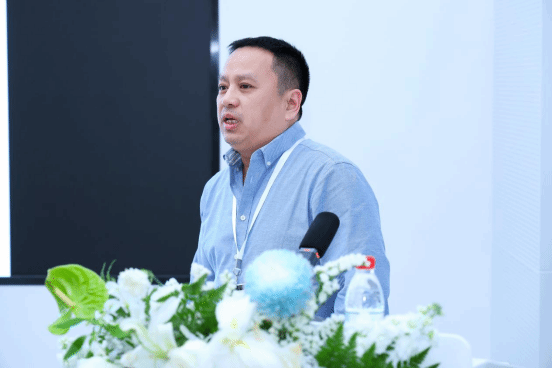
江苏省美术馆副馆长万新华以《相遇方法:傅抱石研究断想》为题进行发言,他首先强调传统的中国美术史研究的目的和方法有两种,一种是侧重于艺术本体的研究,一种是侧重于社会历史学的角度。他认为20世纪后期,西方的中国美术史界把美术作为历史来研究的“外向观”研究一直方兴未艾,这种研究方法多侧重于社会、历史背景下的阐释,而较少关注绘画的笔墨技法、形式风格等本体问题,并忽视画家的个体性,因此缺乏对其绘画风格演变的总体分析和系统研究。最后,他从自身的傅抱石研究中体会方法论,他认为所谓方法论就是观察的视角,他还强调一定要重视过度阐释带来的问题。
Wan Xinhua, Deputy Director of Jiangsu Art Museum , gave a speech entitled "Encounter Method: Thoughts on the Research of Fu Baoshi". He first emphasized that there are two purposes and methods of traditional Chinese art history research. One is to focus on the study of art ontology, and the other is to focus on the perspective of social history. He believes that in the late 20th century, the "external view" of the study of art as history in the Western Chinese art history community has been in the ascendant. This research method focuses on the interpretation under the social and historical background, and pays less attention to the ontological issues such as the brush and ink techniques, formal style of painting, and ignores the individuality of the painter. Therefore, there is a lack of overall analysis and systematic research on the evolution of his painting style. Finally, he experienced the methodology from his own study of Fu Baoshi. He believes that the so-called methodology is the perspective of observation. He also emphasized that we must pay attention to the problems caused by excessive interpretation.
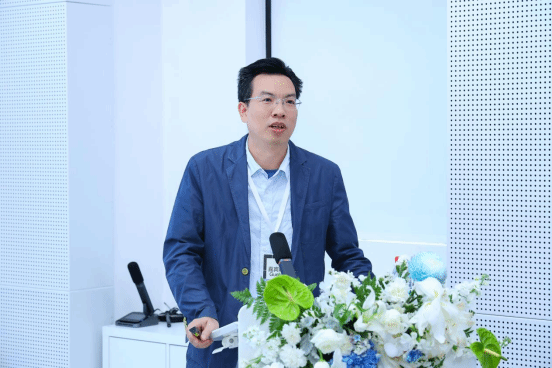
广州美术学院美术学报编辑部主任(常务副主编)李若晴发言的题目为《从天下名胜到地方风景:罗浮山的现代开发与实景山水画、摄影(1920-1938)》,他从天下名胜罗浮山、罗浮山的现代开发、往来罗浮山的广东政要与国府要人、1930年代艺术家的罗浮之行及相关纪游图画和摄影、缺席的岭南画派等五个维度去阐释现今被忽视的名胜“罗浮山”,通过对罗浮山现代开发的历程的探讨,分析相关实景山水画和摄影作品,以及其衰败的原因。
Li Ruoqing, Editorial Director (Executive Deputy editor) of Art Journal of GAFA, spoke on the topic of "From World Attractions to Local Landscapes: the Modern Development of Luofu Mountain and its Realistic Landscape Painting and Photography (1920-1938)". He explained the now neglected scenic spot "Luofu Mountain" from five dimensions: Luofu Mountain, a famous scenic spot in the world, the modern development of Luofu Mountain, Guangdong politicians and government officials who traveled to Luofu Mountain, artists' trips to Luofu in the 1930s and related travel drawings and photography, and the absent Lingnan School of Painting. By exploring the process of modern development of Luofu Mountain , he analyzed the related real-life landscape paintings and photography works, as well as the reasons for their decline.

韩国德成女子大学人文科学研究教授赵敏住发言的题目为《近代早期韩国Ttakji-bon大众小说封面上的中国图像分析——以《郭汾阳实记》为例,她从20世纪初东亚社会和韩国美术、20世纪传统东亚故事在大众书籍出版文化中的视觉再现方式、“新女性”概念、《郭汾阳行乐图》的历史形象变迁等角度去探讨中国与朝鲜传统价值观念变迁和文化关联方面的相互作用,通过分析研究《郭汾阳行乐图》本体与出版物间的视觉形象,进一步提出该研究与近代女性、出版及中韩文化交流密切相关的议题。
Cho Min Ju, Research Professor of the Institute for Humanities Research, Duksung Women’s University, South Korea, spoke on the topic of "Chinese Representation Shown on the Book Covers of ‘Ttakji-bon’ in the Early Modern Korea:Focusing on ‘Gwak Bunyang Silgi’" She explored the interaction between the changes in traditional Chinese and Korean values and cultural connections from the perspectives of East Asian society and Korean art in the early 20th century, the visual reproduction of traditional East Asian stories in popular book publishing culture in the 20th century, the concept of "new women", and the changes in the historical image of "The Pleasures of Gwak Bunyang". By analyzing and studying the visual images between the body of "The Pleasures of Gwak Bunyang" and the publication, she further proposed issues closely related to modern women, publishing, and cultural exchanges between China and South Korea.
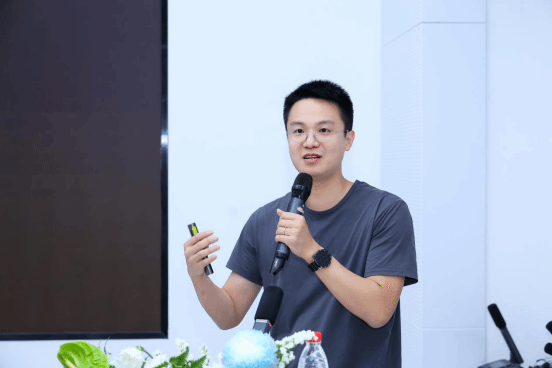
深圳市关山月美术馆副研究员丁澜翔发言的题目为《炉前显身——1950年代炼钢再现的身体媒介与感觉激活》,他以张仁芝的作品《炉前》为切入点,提出两个问题——张仁芝为何仅通过工人的身体便可以表达工业题材的主旨?何种社会观念、视觉文化和创作理念赋予张仁芝画中身体承载工业主题的可能性?他通过“钢厂风景”“身体的缺席”“技术员与机器”“理想形体”“炼钢炼身”“感觉的联想”等几个章节来阐释在文学和艺术作品中,尤其是《炉前》中炼钢的视觉形象是如何塑造的。最后,他引用文艺理论的相关概念,着重分析艺术家张仁芝对作品《炉前》形象的前后改动,并以此来强调艺术家所描绘出的“身体感觉”。
Ding Lanxiang, Associate Researcher of Guan Shanyue Art Museum, Shenzhen, and Researcher of the GAFA Research Center for Chinese Modern Art, gave a speech entitled "The Body as a Method: In Front of the Furnace by Zhang Renzhi and the Sensory Activation of the Reappearance of Steelmaking in the 1950s". He took Zhang Renzhi's work "In Front of the Furnace" as the starting point and raised two questions: Why can Zhang Renzhi express the industrial themes only through the bodies of workers? What kind of social concepts, visual culture and creative concepts give Zhang Renzhi the possibility of the body in his paintings carrying industrial themes? He explained how the visual image of steelmaking is shaped in literary and artistic works, especially in "In Front of the Furnace" through several chapters such as "Steel Plant Landscape", "Absence of the Body", "Technicians and Machines", "Ideal Form", "Steelmaking and Body Refining", and "Association of Feelings". Finally, he quoted relevant concepts from literary and artistic theory, focusing on analyzing the changes made by artist Zhang Renzhi to the image of the work "In Front of the Furnace", and used this to emphasize the "body feeling" depicted by the artist.
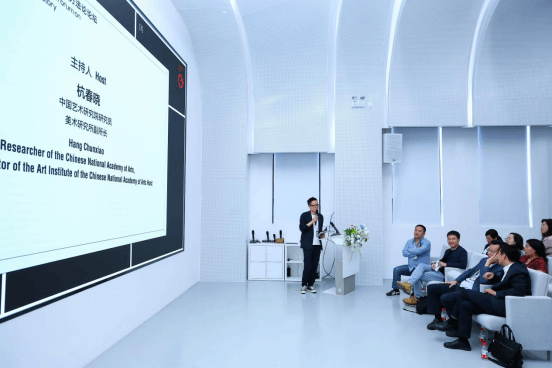
第三单元的议题为“媒介与观念”,该单元由杭春晓主持。
The topic of the third unit is "Media and Concept", which is hosted by Hang Chunxiao.
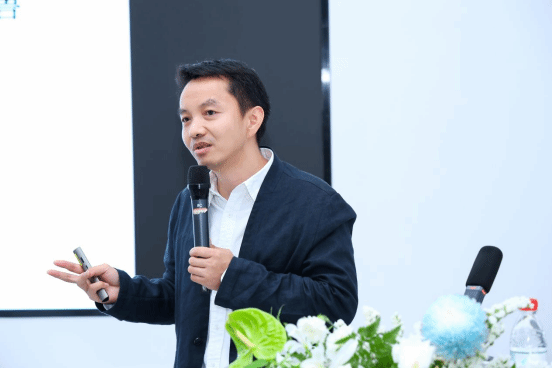
广州美术学院艺术与人文学院院长胡斌发言的题目为《“跨历史”策展与中国近现代美术史中的“跨历史”现象》,他首先强调了“跨历史”概念,以连接历史与当代的“跨历史”策展为切入点,介绍了过往的一些“跨历史”的策展。其次,他提到应该重新发现“传统”,列举了古物陈列所的开放、《女史箴图》的流转、庞薰琹与苏天赐等人的学习和临摹等几个案例,说明了对传统再“审视”的重要性。最后,他提到“传统”的跨国连接与转换,列举了如“六法”“石涛”“八大山人”等案例对东西方之间的文化语境和艺术取向产生影响。他引用《跨历史博物馆》中的“跨历史”来描述这种套叠关系,这种“跨”既摒弃了传统的“欧洲中心主义”,又有异于过分强调本土的“中国中心观”。
Hu Bin, Dean of the School of Arts and Humanities of Guangzhou Academy of Fine Arts, spoke on the topic of "‘Trans-history’ Curation and the Phenomenon of ‘Trans-history’ in Chinese Modern Art". He first emphasized the concept of "trans-history", and introduced some past "trans-history" curatings by connecting history and the present. Secondly, he mentioned that "tradition" should be rediscovered, and cited several cases such as the opening of the Antiquities Exhibition Hall, the circulation of "The Admonitions Scroll", and the study and copying of Pang Xunqin and Su Tianci, etc., to illustrate the importance of "re-examining" tradition. Finally, he mentioned the transnational connection and transformation of "tradition", and cited cases such as "Six Laws", "Shi Tao" and "Zhu Da" to influence the cultural context and artistic orientation between the East and the West. He quoted the "trans-history" in "Trans-historical Museum" to describe this overlapping relationship. This kind of "trans" not only abandons the traditional "Eurocentrism", but also is different from the "China-centrism" that overemphasizes the local.
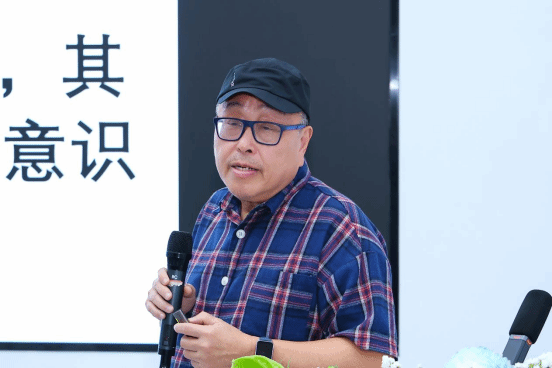
中山大学艺术学院教授杨小彦发言的题目为《媒介纠缠:以陈劭雄和耿建翌的影像实践为案例》,他首先强调了何谓媒介,并引用了德布雷的概念加以阐释。他提到摄影自从被发明开始就遭到了传统艺术界的鄙视,并引用拉斯金、波德莱尔、透纳和德拉罗什的名言予以说明。紧接着他提出“三种眼神的意义”,他将三种发生在绘画与摄影领域的不同眼神,称为“张眼”“艾眼”与“解眼”,与之对应的就是张晓刚、艾轩的作品和希望工程广告作者解海龙选用的眼睛。最后,他总结出“两个另类”,这两位就是陈劭雄和耿建翌,他举例两位艺术家的作品,认为他们都是以摄影为媒介进行艺术实践的另类,既对绘画产生颠覆,又对摄影产生了颠覆。
Yang Xiaoyan, Professor of the School of Arts at Sun Yat-sen University, spoke on the topic of "Media Entanglement: A Case Study of Chen Shaoxiong and Geng Jianyi's Video Practice". He first emphasized what media is and quoted Debray's concept to explain it. He mentioned that photography has been despised by the traditional art world since its invention, and quoted the famous sayings of Ruskin, Baudelaire, Turner and Delaroche to explain it. Then he proposed the "meaning of three kinds of eyes". He called the three different eyes in the fields of painting and photography "Zhang eyes", "Ai eyes" and "Jie eyes", which correspond to the works of Zhang Xiaogang and Ai Xuan and the eyes chosen by Xie Hailong, the author of the Hope Project advertisement. Finally, he summarized "two alternatives", these two are Chen Shaoxiong and Geng Jianyi. He cited the works of the two artists and believed that they are both alternatives who use photography as a medium for artistic practice, which has subverted both painting and photography .
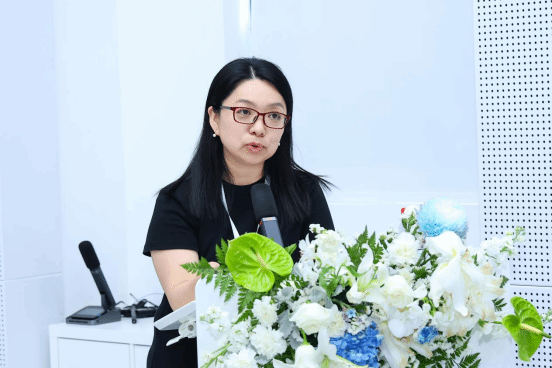
广州美术学院中国近现代美术研究所助理研究员许珍发言的题目为《文化记忆与身份认同:记忆理论视野下的“岭南画派”》,她首先强调了“记忆”的概念,继而引用了扬·阿斯曼的概念,依托阿斯曼“文化记忆”概念从而引导出“身份认同”这一主要特征。她强调文化记忆的主要功能就是为身份“定位”,对知识的使用和传播是由“认同需要”控制的。她认为身份认同就是“岭南画派”记忆文本指涉的核心问题。在这种视野下,随着“岭南”二字的冠名,“岭南画派”的含义阐释和意义生发都发生了变迁,并且在重建形象和文化记忆的时候,基于一个认同的需要认领了这种误读。综上,在记忆视角下的“岭南画派”就为我们提供了一个鲜活的文化记忆的建构样本。
Xu Zhen, Assistant Researcher at RCCMA of GAFA, spoke on the topic of "Cultural Memory and Identity: Lingnan Painting School from the Perspective of Memory Theory". She first emphasized the concept of "memory", and then quoted Jan Assmann's concept, relying on Assmann's concept of "cultural memory" to lead to the main feature of "identity". She emphasized that the main function of cultural memory is to "position" identity, and the use and dissemination of knowledge is controlled by the "need for identity". She believes that identity is the core issue of the memory text of the "Lingnan Painting School". In this perspective, with the naming of the word "Lingnan", the interpretation and meaning of the "Lingnan Painting School" have changed, and when reconstructing the image and cultural memory, this misunderstanding is claimed based on the need for identity. In summary, the "Lingnan Painting School" from the perspective of memory provides us with a vivid sample of the construction of cultural memory.

中央美术学院人文学院教授吴雪杉以《歌与画:<义勇军进行曲>的跨媒介转换》为题进行发言,他首先以义勇军进行曲作品的图像化为切入点,列举了一歌多图的“义勇军进行曲”,分别为佚名《义勇军进行曲,救亡的画,救亡的歌》、高龙生《义勇军进行曲图解》、王寄舟《义勇军进行曲歌词》这三件作品,紧接着去阐释如何把歌曲变成完整的图像叙事,以及如何用图像来表达歌曲未能表现的叙事。他总结道,这种用画来表达抗战歌曲的作品在当时被称为“歌画”,同样,这也涉及到了媒介间性的问题。最后,他大胆地对《救亡的画,救亡的歌》的佚名作者进行考证,他认为对待这种无法用高科技手段辨析的图像,只能用最传统的风格分析来对比,由此他得出结论认为该作品的风格与陈烟桥的风格极其相似。
Wu Xueshan, Professor of the School of Humanities at the Central Academy of Fine Arts , gave a speech entitled "Song and Painting: the Transmedia Transformation of the March of the Volunteers". He first took the visualization of the March of the Volunteers as the starting point, and listed three works of "March of the Volunteers" with multiple images, namely "March of the Volunteers, Paintings of National Salvation, Songs of National Salvation" by an anonymous author, "Illustration of the March of the Volunteers" by Gao Longsheng, and "Lyrics of the March of the Volunteers" by Wang Jizhou. He then explained how to turn songs into complete image narratives, and how to use images to express narratives that songs fail to express. He concluded that this kind of work that uses paintings to express anti-Japanese war songs was called "song painting" at the time, and similarly, this also involves the issue of intermediality. Finally, he boldly examined the anonymous author of "Paintings of National Salvation, Songs of National Salvation". He believed that for such images that cannot be analyzed by high-tech means, only the most traditional style analysis can be used for comparison. From this, he concluded that the style of this work is extremely similar to that of Chen Yanqiao.
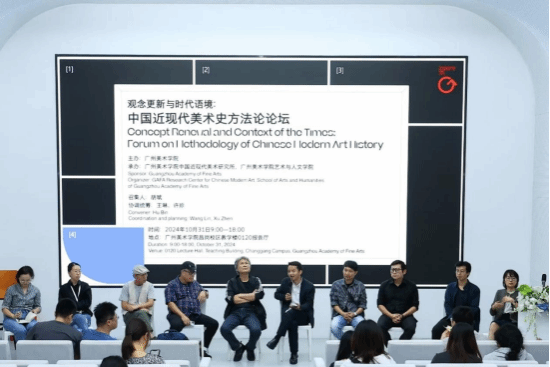
最后,李伟铭、杨小彦、艾姝、郑梓煜、杨简茹、何小特、王艾、陈旭、王琳等嘉宾围绕整场的议题进行了回应与圆桌讨论。
Finally, guests including Li Weiming, Yang Xiaoyan, Ai Shu, Zheng Ziyu, Yang Jianru, He Xiaote, Wang Ai, Chen Xu, and Wang Lin responded and had a round table discussion around the entire topic.
